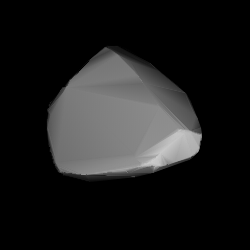
Medusa is a bright-coloured, stony main-belt asteroid that was discovered by French astronomer J. Perrotin on September 21, 1875, and named after the Gorgon Medusa, a snake-haired monster in Greek mythology. It is orbiting the Sun at a distance of 2.17 AU with a period of 3.21 years and an eccentricity of 0.065. The orbital plane is tilted slightly at an angle of 0.94° to the plane of the ecliptic.

Vincentina is a fairly large main belt asteroid.

Huberta is a large asteroid orbiting near the outer edge of the Main belt. It is dark and rich in carbon.

Dresda is a typical Main belt asteroid. It belongs to the Koronis family of asteroids.

Tirza is a fairly sizeable, very dark Main belt asteroid.

343 Ostara is a background asteroid from the inner region of the asteroid belt. It was discovered by German astronomer Max Wolf at the Heidelberg Observatory on 15 November 1892.
Hungaria is a relatively small asteroid orbiting in the inner asteroid belt. It is an E-type (high-albedo) asteroid. It is the namesake of the Hungaria asteroids, which orbit the Sun on the inside of the 1:4 Kirkwood gap, standing out of the core of the asteroid belt.

Ella is a typical Main belt asteroid. It was discovered by Max Wolf and A. Schwassmann on 11 September 1898 in Heidelberg. This is the eponymous member of a proposed asteroid family with at least 15 members.

Patricia is a large Main belt asteroid.
Zeuxo is a large Main belt asteroid.
Ohio is a large Main belt asteroid.

Bathilde is a large main belt asteroid that was discovered by French astronomer Auguste Charlois on 8 December 1898 in Nice. 441 Bathilde is orbiting close to a 5:2 mean motion resonance with Jupiter, which is located at 2.824 AU.
Caprera is a minor planet orbiting the Sun.

Nassovia is a minor planet orbiting the Sun. It is a member of the Koronis family of asteroids.

621 Werdandi is a Themistian asteroid.
623 Chimaera is a minor planet, specifically an asteroid orbiting in the asteroid belt.
633 Zelima is a minor planet orbiting the Sun in the asteroid belt with a magnitude of 10.7. The name may have been inspired by the asteroid's provisional designation 1907 ZM.

662 Newtonia is a minor planet, specifically an asteroid orbiting mostly in the asteroid belt.
768 Struveana is a minor planet orbiting the Sun. The asteroid was named jointly in honor of Baltic German astronomers Friedrich Georg Wilhelm von Struve, Otto Wilhelm von Struve and Karl Hermann Struve.

852 Wladilena is a Phocaea asteroid from the inner region of the asteroid belt. It is named after the Russian Communist leader Vladimir Lenin.













